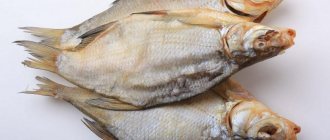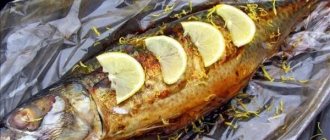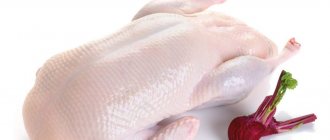Tilapia or Telapia: benefits and harms, calorie content, photos, recipes with photos.
PP recipes in the oven
Home » Benefits and harms » Meat and fish »
Among the wide range of commercial fish presented on the market, there are species that are ambiguous in their impact on human health. Discussions about the benefits and harms of tilapia are taking place not only among doctors, but also among consumers. To understand whether this fish is so dangerous, it would be useful to study its chemical properties.
What kind of fish is this and where is it found?
Tilapia is a generic name that unites several hundred species of freshwater fish of the cichlid family. Initially, fish of this genus lived mainly in Asia Minor and Africa, but thanks to people they became widespread in Europe, Latin America and Southeast Asia.
In terms of external characteristics, the different species do not differ much from each other and have a short, slightly laterally compressed body and a large head with large eyes, typical of cichlids. Their color is most often silver with a greenish tint. The average weight of fish ranges from 1 to 1.5 kg.
Tilapia are considered almost omnivores, but most of their diet consists of plant matter, such as phytoplankton and large algae. Organic bottom sediments occupy an important place in the nutrition of many species.
The main property of fish of the tilapia genus is their ability to adapt to sudden changes in environmental conditions. Although tilapia prefer tropical climates and are freshwater fish, they are able to survive in seawater and can withstand fairly low temperatures.
Easy care and excellent taste make these fish valuable objects for industrial cultivation. They are actively bred in artificial reservoirs in China, Latin America and the USA.
Tilapia, calories and benefits | Healthy eating
Nov-8-2017 Author: KoshkaS
What is tilapia?
Tilapia (tilapia) is a very “smart” fish; its habits resemble those of pets, however, this does not prevent a huge number of people from enjoying its taste. Tilapia belongs to the freshwater fish of the Cichlid family; its body is compressed on the sides, short, and tall. The color of the fish is uniform, silver-gray, sometimes green.
The head is large with large eyes, the rays of the anal and dorsal fins are long.
Presumably, the fish received the name “tilapia” from an African tribe that lives on Lake Malawi.
There is also historical information that at different times it was called “St. Peter’s fish,” sometimes “river chicken,” the Arabs called it musht, and the Israelis called it amnun. The economic importance, as well as the nutritional and cultural value of fish, is great.
Now many specialists are studying the characteristics and habits of this fish; animal psychologists are interested in it (in terms of numerous conditioned reflexes, tilapia can be compared with a dog), as well as specialists in underwater acoustics. However, most of the world's population still appreciates this fish for its amazing taste. Today, numerous fisheries in Africa, Asia, the USA, Latin America and some European countries happily breed tilapia.
Cooks from different countries can offer a huge number of recipes for preparing tilapia; this fish can be boiled, baked, stewed and fried on a grill or frying pan.
Tilapia meat contains a lot of balanced protein (amino acid composition), as well as many vitamins, macro- and microelements. Due to its composition, tilapia must be present in the diet of pregnant women, children and the elderly.
Some American researchers claim that tilapia meat is harmful because it contains an incorrect ratio of omega-3 and omega-6 polyunsaturated fatty acids (1:3). However, most likely, this group of researchers did not take into account the fact that tilapia meat is low in fat and cannot lead to an imbalance of fatty acids in the body.
How many calories are in tilapia?
The calorie content of telapia is not very high, which makes it an excellent dietary product.
Low calorie content is ensured due to the optimal ratio of proteins and fats. People who want to lose weight can safely include tilapia in their diet. Well, the calorie content of fresh tilapia is:
96 kcal per 100 grams of product
Proteins, fats and carbohydrates (BJU) of fresh tilapia per 100 grams:
Proteins - 20.1
Fats – 1.7
Carbohydrates – 0.0
The calorie content of fried tilapia is:
128 kcal per 100 grams of product
Proteins, fats and carbohydrates (BJU) of fried tilapia per 100 grams:
Proteins - 26.1
Fats – 2.6
Carbohydrates – 0.0
Recipe? Recipe!
What can you cook from tilapia? Here are some recipes:
Tilapia with potatoes in a pot:
You will need:
- 300 g tilapia;
- 3 potatoes;
- 1 onion;
- 1 carrot;
- 2 tbsp. spoons of low-fat sour cream;
- salt and pepper.
Cooking method:
- Peel carrots, potatoes and onions. Grate the carrots, chop the onion, cut the potatoes into thin slices.
- Wash the fish, cut into small pieces, salt and pepper.
- Place potatoes, fish, onions and carrots in layers at the bottom of the pot. Pour some water and put sour cream on top.
- Cover the pots with lids and place in the oven, preheated to 180 °C. Cook for about 30–40 minutes.
Tender tilapia cutlets:
You will need:
- tilapia fillet – 3 pcs.
- yogurt without additives - 3 tbsp. spoons
- raw egg – 1 pc.
- fresh dill – 1 bunch
- green onion – 1 bunch
- salt - to taste
- seasoning for fish - to taste
- potato starch – 1 teaspoon
- white flour – 50 g.
- vegetable oil – 50 ml.
Cooking method:
Wash the fillet and dry it. Grind in a blender, add salt, yogurt, eggs, herbs and starch. Let stand for 15 minutes. Mix well. Use a spoon to form cutlets and roll them in flour. Fry over medium heat until done.
Fish on a bed of vegetables (4 servings):
You will need:
- 400 g tilapia fillet
- 200 g frozen mixed vegetables
- a few slices of lemon
- a few sprigs of dill and parsley
- rosemary
- ground black pepper
- seasonings for fish.
Cooking method:
Preparation: 30 min.
Tilapia fillets are washed and dried. Rub the fillet with salt, pepper, seasonings, leave for 15 minutes, cut into portions. Pour water into the multicooker and place a plate for steaming. Place the vegetable mixture on this plate and sprinkle it with a little salt. A fish fillet is placed on top of the vegetables, and a slice of lemon, a sprig of herbs and a pinch of rosemary are placed on each piece of fish. Close the multicooker and set the “Steam” or “Pressure Cooking” mode.
Share the article with your friends on social networks!
More on the same topic:
prokalorijnost.ru
What are the benefits of tilapia?
Despite rumors about the dangers of tilapia, it is difficult to ignore its benefits for the human body. Nutritionists recommend eating this fish fillet to everyone, especially children, as well as pregnant and lactating women.
For adult men and women
The beneficial properties of tilapia for adults are that its fillet contains half the daily requirement of protein, which is a building material for cells and is involved in all processes of the human body. Protein is especially important for people who exercise intensively, as it actively participates in the formation of muscle mass.
Vitamin E, which is part of fish, ensures the elasticity of blood vessels and the elasticity of the skin, which eliminates the danger of thrombosis and prolongs youth.
For the elderly
Tilapia is no less useful for older people. The magnesium and Omega-3 acids found in fish regulate blood cholesterol levels, normalize blood pressure, reduce the risk of heart and joint diseases, maintain healthy vision, and inhibit inflammatory processes in the body. Phosphorus and potassium, in turn, ensure bone strength and reduce the likelihood of developing dementia and Alzheimer's disease.
Calorie content of tilapia
Calorie content of tilapia is 96 kcal per 100 grams.
Useful properties of tilapia
It is a dietary protein product, a source of vitamins and minerals.
- The product contains almost all B vitamins; they have a good effect on the functions of the nervous system. This fish is simply necessary in the winter diet.
- Vitamin E is a powerful antioxidant that preserves youth and health.
- For hematopoietic processes and for anemia, it is recommended to consume tilapia, which contains a lot of vitamin K.
- There is so much phosphorus and iron here that it perfectly allows you to replenish your daily intake. It will support the functioning of the heart, have a beneficial effect on brain function and will simply become irreplaceable for children and adolescents during a period of active growth.
As mentioned above, eating this fish can also be harmful. Omnivorous tilapia accumulates in its body all the harmful substances on which it feeds, and is also susceptible to infection by helminths. Unfortunately, all these unfavorable facts lie entirely in the conscience of the manufacturer. It is also worth paying attention to the imbalance of fatty acids with a predominance of omega-6, which is considered not very beneficial for the heart, although this issue has not yet been well studied.
How to choose tilapia
Choosing tilapia is not difficult. Just pay attention to the manufacturer; a good manufacturer will protect the consumer from possible harm in the product and will test the batch in the laboratory. Naturally, like any other fish, it must be stored correctly; repeated defrosting and freezing is not allowed.
What to cook from tilapia
Cooking fish is pleasant and easy; it lends itself well to heat treatment. It can be fried in different ways, steamed, baked in the oven, stewed in various sauces. It is perfectly prepared both “solo” and in combination with other products. Tilapia fillet is flexible enough to make rolls with all sorts of fillings. This fish is very tasty and harmonious in composition - the average fat content helps it successfully balance on the brink of taste and benefit; it’s not for nothing that tilapia is called “king perch.”
Belonging to the cichlid family. This family has hundreds of species. As a rule, their habitat is the tropics. From the general family, several subfamilies can be distinguished, which in Russian are called “tilapia” with the emphasis on the second vowel.
Why was she called that? They say that in distant Africa a certain lake tribe gave the fish such a name, according to their language. There is also a funnier version of the origin of the name tilapia. Almost anecdotal. She is connected with Aristotle. The scientist tasted the fish meat, clapped his hands in frustration and said: “It’s a pity that this fish is tilapia,” i.e. “distant” in translation.
There are a number of other names. We will not focus our attention on them. Suffice it to say that a number of grocery supermarkets display seafood on display under the name “chicken of the river” or “chicken of the sea.”
Tilapia from a biological point of view
The most likely area of origin of the fish is Asia Minor. But as a result of human intervention, it spread to the vast expanses of all of Asia and affected the African continent. There are many different subspecies and modifications of tilapia.
Fish of the cichlid family are hardy and can quickly adapt to climate changes, which is also typical for tilapias. Internal communication occurs using signals. Within species, so-called “mating pairs” are created, bearing offspring through the generation of babies from eggs. Each couple is an active owner of their territory.
According to the feeding method, tilapia is either omnivorous or feeds on aquatic vegetation (depending on the species). Some species of the family even manage to feed on underwater soil. These are precisely the species that feed on incompletely processed organic matter.
Accelerated maturation of fish is facilitated by their absorption of detrital amino acids. Males develop and acquire the ability to grow earlier than females. The spawning period occurs when the water warms up to 25 and above. Tilapia usually produces offspring once a month, under appropriate conditions.
To protect their young, almost all fish hide their eggs in their mouths. The process of formation of fry takes about a month. Then there is a gradual “release” of young fish. They are taught to live independently.
By holding the spawned eggs in this way, tilapia performs several functions: protective (the offspring are not exposed to the harmful effects of the external environment), sanitary (careful inspection of the eggs, defective or sick individuals are mercilessly removed). Also, some types of tilapia produce eggs in a standard manner, like most other fish. They throw it on an external surface, for example, rocky ground, and jealously protect their offspring from the encroachments of strangers.
Tilapia. Calorie content
Tilapia meat is juicy and almost fat-free with plenty of protein. It is consumed fried, baked or as a steamed decoction. The fewer red veins in the fish, the tastier its fillet. Fish is unpretentious in preparation, which provides ample opportunities for creative culinary activities.
Nutritionists have calculated the daily portion of tilapia fish product. The calorie content of a regular diet does not exceed 2 kcal per day. For such a dietary diet, this is approximately one average serving per 99.22 g. Composition of tilapia: calories - 98, protein - 18.5 g, fat - 2.4 g (4%), sodium - 0.052 g.
Industrial content
In cooking, the tender protein meat of tilapia has become a kind of gastronomic delicacy. Tilapia, a high percentage of protein in the meat and moderate fat content, allows us to talk about it as a dietary dish. The mentioned breed of cichlids is equally important for breeding. This fish is hardy, omnivorous and universally adapts to any water, be it fresh or salty.
Is tilapia suitable for pregnant and lactating women?
Tilapia: One of the few fish species that can be safely consumed by pregnant and lactating women. Like salmon, it does not contain mercury, the excess of which has a harmful effect on the child, and the presence of vitamins and minerals in its composition helps maintain the mother's immunity. Fish also contains beneficial Omega-3 fatty acids, which are necessary for the healthy development of the fetal nervous system during pregnancy.
We recommend reading: Halibut fish: description, benefits and possible harm to the body
How to eat tilapia correctly
A huge advantage of tilapia is not only the small number of bones in the carcass, but the virtual absence of a specific fishy smell and taste. That’s why culinary experts recommend baking, stewing, or frying tilapia using various sauces - they will add a more pronounced taste to the finished dish and it will not be bland.
Very tasty fried tilapia, and you don’t have to worry about eating too fatty a product - the presented fish is distinguished by lean meat, so you can safely introduce it into the diet of people with diseases of the gastrointestinal tract.
In order for cooked tilapia to truly delight you with its taste, you need to learn how to choose it correctly. To do this, remember just a few rules :
- if tilapia is sold whole, then its color should be gray with small black spots;
- the surface of a fresh carcass will be shiny, without yellow or brown spots;
- If you buy tilapia fillet, make sure that it contains only a small proportion of ice, and that the color of the product is white, with a slight yellowish-cream tint.
Please note: if tilapia fillet will be cooked in the oven, be sure to cover it with foil, and when stewing the product in question, add wine or any sauce to it - this will make the dish more tender and juicy.
Tilapia is considered one of the most affordable fish on the market, so you need to regularly include it in the diet of the whole family. Considering that there are no contraindications for consumption by age group, tilapia will be an excellent alternative to meat and sausages.
8, total, today
( 161 votes, average: 4.57 out of 5)
Pangasius: benefits and harms
Herbs for weight loss
Related Posts
Is it possible to give tilapia to children?
Since tilapia has a tender, almost boneless fillet that softens well when cooked, it is quite suitable for baby food. As a rule, they begin to accustom a child to such food at 7:8 months, provided that the child is bottle-fed. Breastfed children do not need early complementary feeding.
Important! Before introducing fish into your child's diet, it is recommended to consult a doctor.
An ideal option for complementary feeding would be fish puree. When feeding fish for the first time, you should limit yourself to 1 tsp. for meals. The next portion should be given no earlier than 24 hours later. During this time, it will become clear whether the child has allergic reactions to tilapia. If after a period of time no such reactions are detected, you can gradually increase the dosage to 50 g per dose.
Tilapia is good for children of any age, as it contains phosphorus, which helps absorb calcium and plays an important role in the formation of bone tissue.
Protein source
Tilapia fish is a source of low-calorie protein.
According to the USDA, in a 100-gram serving of this fish you will find 26 grams of protein, which is about 52% of your daily value. An excellent way to meet the body's needs for healthy cell growth, tissue regeneration and wound healing. Moreover, the protein in question is 100% complete. In other words, it contains all the amino acids your cells, tissues and organs need. It is quite expected that the Centers for Disease Control and Prevention, scattered throughout the United States, strongly recommend diversifying the diet with low-calorie fish. This should reduce the risk of many chronic diseases.
Recommendations for eating tilapia
Although tilapia fillet has many beneficial properties, many people are afraid to eat it. Since tilapia is an omnivorous fish, it is believed that it feeds on harmful human waste, as a result of which it accumulates toxins in its body. However, this is a misconception. All hazardous substances, if any, are retained in the liver of the fish, which, like the human liver, performs a protective function and neutralizes the effects of poisons. Therefore, before eating, tilapia should be gutted and washed thoroughly. This will also reduce the risk of infection from pathogenic bacteria that may be present in the fish.
Step by step recipe
Step #1. Wash, dry and cut tilapia fillets into pieces.
Step #2. Rub the pieces with salt and brush with olive oil. Place the fillet in the multicooker bowl to steam the dish. If you don't have a slow cooker, you can place the fish in a regular pan. Cook like this for about fifteen minutes.
Step #3. Once cooked, place the finished pieces of tilapia on a serving dish.
Step #4. We wash the cherry tomatoes, cut them in half, and distribute them with the fish.
How to cook tilapia fillet
There are many recipes for tilapia fillet dishes. It can be stuffed, steamed, boiled, baked in foil, smoked, and in combination with drier fish it becomes an excellent filling for pies. But the most popular and fastest ways to cook tilapia are to bake in the oven or fry.
Tilapia baked in the oven
To prepare 4 servings of the dish you will need:
- peeled fish fillet: 4 pcs.;
- medium size lemon: 1 pc.;
- mayonnaise: 4 tbsp. l.;
- any greens: 2 tbsp. l.;
- horseradish: 2 tsp;
- garlic spice: 1 tsp;
- salt and pepper to taste.
- Cover the baking sheet with foil and place the fillets on it without adding oil. Sprinkle with salt, pepper and garlic spice and bake for 20 minutes at 200C°.
- The lemon is peeled and the zest is ground in a blender.
- Horseradish, mayonnaise and finely chopped herbs are mixed for sauce, add 1 tsp to the mixture. lemon zest.
- The finished fillet is sprinkled with lemon juice and served with sauce as a separate dish or with a side dish of vegetables, pasta or rice.
Tilapia in batter
For 4 servings you need:
- tilapia fillet 8 pcs.;
- flour 300 g;
- chicken egg 2 pcs.;
- vegetable oil 2 tbsp. l.;
- salt, pepper and herbs: to taste.
- The washed fillet is cut into pieces.
- Beat the eggs thoroughly with a fork or blender until smooth.
- Mix flour with salt and pepper.
- The fillet pieces are first rolled in flour, and then in egg, then placed in a frying pan with heated vegetable oil.
- Fry the fish on both sides for 7:8 minutes until golden brown.
- Place the finished fillet on a paper towel to remove excess oil. Served hot with a side dish.
Advice! In addition to eggs, you can use milk, kefir or beer as a base for the batter.
Tilapia with potatoes
For this tilapia recipe you will need: 0.3 kilograms of potatoes, 0.5 kg of tilapia fillet, half an onion, a glass of milk, 2 tablespoons of mayonnaise sauce, 100 grams of grated hard cheese.
A dish for the oven is prepared as follows: first, potatoes are peeled and cut into slices, then they are laid out in a dense layer on a baking sheet. The fish should be washed, dried with a paper towel and placed on top of the potatoes. Sprinkle the workpiece with a mixture of peppers. Next we are making the sauce.
To do this, mix mayonnaise, milk and cheese. Mix the sauce thoroughly and use it to soak the fish. You need to preheat the oven to 190 degrees and place a baking sheet in it. 30 minutes is the time for baking the fish. You can determine readiness by the crispy, golden-colored crust.
Harm of tilapia and contraindications for use
The main disadvantages of tilapia include the incorrect combination of Omega-3 and Omega-6 fatty acids.
Attention! The Omega-6 and Omega-3 acids contained in tilapia, which are important for their benefits, in the human body should have a 1:1 ratio, the violation of which in the direction of Omega-6 threatens the development of inflammation and disruption of the immune system.
Recent studies by American nutritionists have shown that in tilapia fillet the level of Omega-6 acid can exceed the level of Omega-3 by more than 4 times.
We recommend reading: What are the benefits of nutria meat, the healing properties of fat
Omega-6 itself has the beneficial property of lowering blood cholesterol levels. However, it also has a negative reputation as an inflammatory fatty acid, while Omega-3 has proven anti-inflammatory effects.
However, tilapia is not as serious as it may seem. The Omega-6 content in it is much less than the critical value. However, you should observe moderation and eat this fish no more than 2:3 times a week.
Also, tilapia should not be abused by people suffering from:
- bronchial asthma;
- allergies;
- individual intolerance to the product;
- diseases of the cardiovascular system;
- arthritis and other joint diseases.
Calorie content of tilapia fillet. Chemical composition and nutritional value.
Nutritional value and chemical composition of “Tilapia fillet”.
The table shows the nutritional content (calories, proteins, fats, carbohydrates, vitamins and minerals) per 100 grams of edible portion.
| Nutrient | Quantity | Norm** | % of the norm in 100 g | % of the norm in 100 kcal | 100% normal |
| Calorie content | 128 kcal | 1684 kcal | 7.6% | 5.9% | 1316 g |
| Squirrels | 20.8 g | 76 g | 27.4% | 21.4% | 365 g |
| Fats | 2.65 g | 56 g | 4.7% | 3.7% | 2113 g |
| Water | 78.08 g | 2273 g | 3.4% | 2.7% | 2911 g |
| Vitamins | |||||
| Vitamin B1, thiamine | 0.09 mg | 1.5 mg | 6% | 4.7% | 1667 g |
| Vitamin B2, riboflavin | 0.07 mg | 1.8 mg | 3.9% | 3% | 2571 g |
| Vitamin RR, NE | 4.75 mg | 20 mg | 23.8% | 18.6% | 421 g |
| Macronutrients | |||||
| Potassium, K | 380 mg | 2500 mg | 15.2% | 11.9% | 658 g |
| Calcium, Ca | 14 mg | 1000 mg | 1.4% | 1.1% | 7143 g |
| Magnesium, Mg | 34 mg | 400 mg | 8.5% | 6.6% | 1176 g |
| Sodium, Na | 56 mg | 1300 mg | 4.3% | 3.4% | 2321 g |
| Phosphorus, Ph | 204 mg | 800 mg | 25.5% | 19.9% | 392 g |
| Microelements | |||||
| Iron, Fe | 0.69 mg | 18 mg | 3.8% | 3% | 2609 g |
| Sterols (sterols) | |||||
| Cholesterol | 50 mg | max 300 mg | |||
| Saturated fatty acids | |||||
| Saturated fatty acids | 0.77 g | max 18.7 g |
The energy value of tilapia fillet is 128 kcal.
Primary Source: Created in the application by the user. Read more.
** This table shows the average levels of vitamins and minerals for an adult. If you want to know the norms taking into account your gender, age and other factors, then use the “My Healthy Diet” application.
health-diet.ru
How to choose tilapia when buying
To purchase the most useful product, you should pay attention to the appearance of the tilapia.
- An uncut carcass's eyes should be transparent and shiny. If the eyes are cloudy, there is a high chance that the fish is not fresh.
- Preference should be given to carcasses with pale, intact scales and long fins, which are a sign that the fish was raised on natural feed.
- Fresh tilapia has a faint river aroma. If the product smells like medicine, most likely the fish has been chemically treated for better storage.
- When purchasing fillets, you should choose a product that has a uniform, soft color. Too rich a color is an indicator of the presence of harmful food additives in the fish. Natural fillets may contain bones.
- It is best to purchase chilled fillets, since tilapia loses a significant part of its beneficial properties during freezing.
It is very important to purchase tilapia from reputable places, since it is not always possible to determine the quality of the product by eye. This is often taken advantage of by irresponsible fish farmers who breed unpretentious fish in contaminated or dirty reservoirs, feeding them with antibiotics to accelerate growth. Tilapia fillets grown in this way will do more harm to the body than good.
Advice! When buying fish, you should ask the seller for a quality certificate.
Tilapia in cooking
Tilapia is widely used in cooking for preparing various dishes. This type of fish is prepared by boiling, frying, baking, steaming and smoking. Tilapia is used to prepare hot and cold appetizers, soufflés, marinated dishes, and is also used as an additive to salads. If the dish involves frying tilapia, then during heat treatment, the fish is additionally poured with sauce, water or white wine, which allows you to achieve the juiciness of the finished dish. A popular dish in cooking is tilapia fillet baked in foil with lemon zest, spices and fresh herbs. This fish goes harmoniously with mushrooms, boiled quail eggs, hard cheese, various vegetables, potatoes and boiled rice.
When choosing a fish, you need to pay attention to the condition of its eyes. If they have a characteristic bright shine and transparency, then the product can be considered fresh. The scales on the fish should not be damaged and should come off quickly. Any foreign odors, with the exception of the characteristic smell of fish, are a sign of staleness of the product. In addition, excessively rough scales and excessively long fins indicate that the tilapia was raised in artificial conditions using questionable feed.
Tilapia (also called king perch) is a generic name for several species of fish common in the tropical waters of eastern Africa. Some fish species can tolerate low temperatures. It has a great external resemblance to flounder. The fish tastes like chicken.
Before buying a new product, you need to study its properties. This also applies to tilapia fish, the benefits and harms of which must be studied before eating it. The high content of useful microelements and vitamins allows it to be recommended for children, pregnant women and the elderly.
Beneficial features:
- Has low calorie content;
- Tilapia contains a high amount of easily digestible proteins;
- Contains B vitamins;
- High content of useful microelements (potassium, magnesium, phosphorus, calcium), so it can be consumed by children;
- Tilapia meat contains polyunsaturated fatty acids that are not produced by the human body on its own;
- Supports the functioning of the cardiovascular system;
- Due to the high content of iron and phosphorus, it improves brain function;
- Stimulates the production of red blood cells (erythrocytes);
- Thanks to the vitamin E content, it slows down the signs of aging and allows you to maintain youth;
- Normalizes the functioning of the nervous system;
- Increases hemoglobin levels;
- Helps with anemia;
- The proteins contained in fish promote rapid wound healing, as well as ensure healthy cell growth and tissue repair;
- Due to the content of vitamins E and K, regular consumption of tilapia meat helps reduce the occurrence of depression, reduces loss of energy and helps with frequent mood changes.











